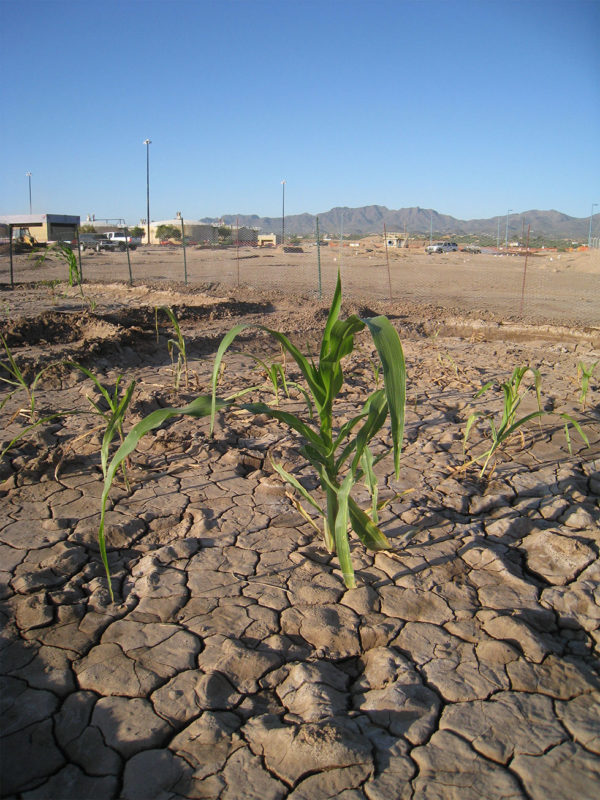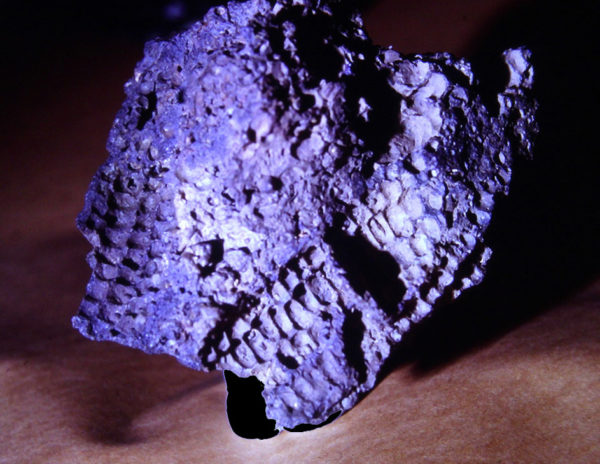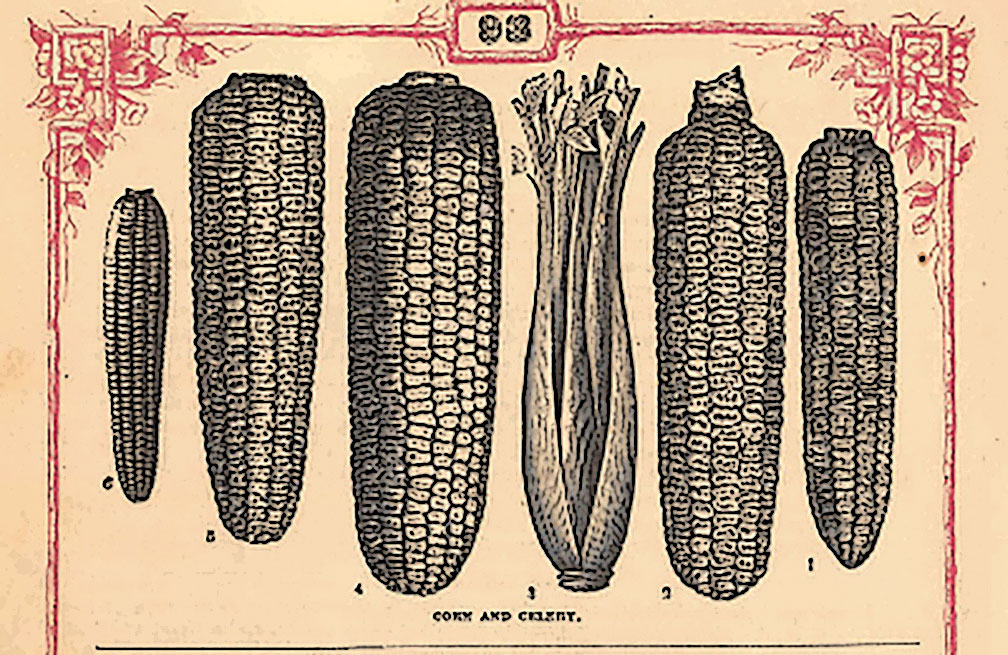
Maize and Experimental Archaeology
Dr. James Vint, Dr. Jenny Adams, and Dr. Mark Elson discuss Desert Archaeology experiments with maize.
Sometimes archaeologists conduct experiments to better understand how things were done in the distant past. Over the years, Desert Archaeology researchers have conducted three different kinds of experiments to understand how maize was grown, ground, and ritually used.
Early Agricultural period field construction
In 2009, Desert Archaeology conducted archaeological work at the Ina Road Waste Water Treatment Plant prior to the construction of deep tanks. Backhoe operator Dan Arnit carefully stripped large areas, scraping away layers of overlying soil to reveal an immense ancient field system of canals, field cells, and bunds (also called berms). The field areas were darker than the surrounding ground due to the organic material that was deposited during the years the fields were used. Lighter colored ditches and bunds could be discerned. The fields dated to the San Pedro phase of the Early Agricultural period (1200 to 800 BC).
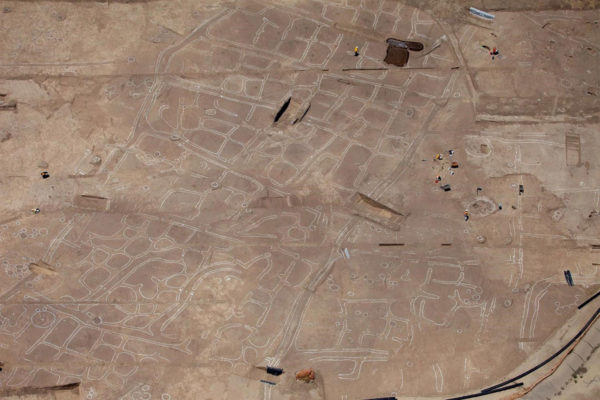
An aerial photograph of one of the field areas showing the uncovered field cells and the ditches used to bring water into them. Archaeologists outlined the ditches and bunds white paint to make these features more visible in photographs. Workers appear as tiny figures in orange vests and white hard hats in the right portion of the frame (photo by Henry Wallace)
To better understand the labor investment and potential crop returns represented by these features, we decided to investigate how long it might have taken the San Pedro phase farmers to create parts of the field system. Archaeologists re-excavated some of the ancient field cells using digging sticks, recording individual work time and the sizes of the cells that they created.
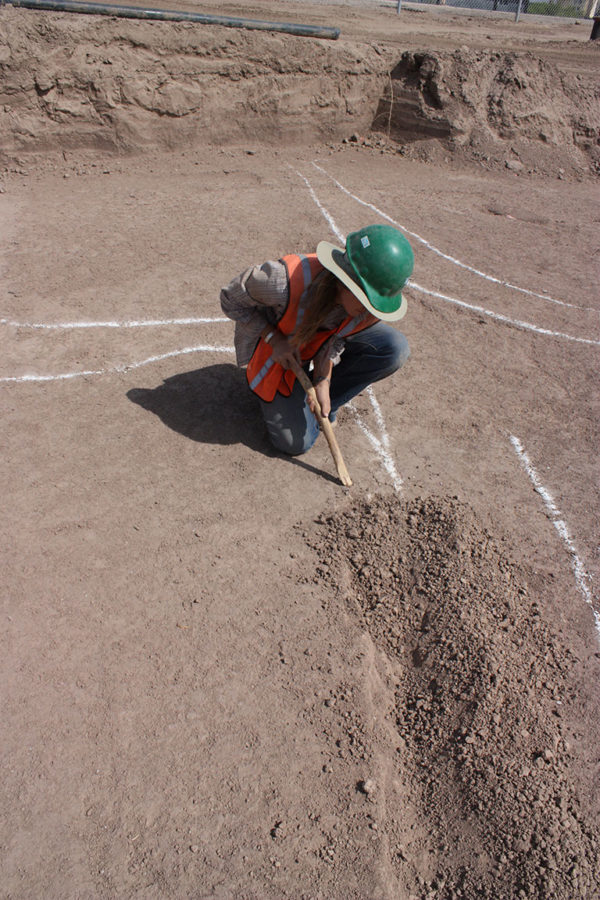
A crew member uses a digging stick to create a trench around the field cell (photo by Allen Denoyer).
It took about 30 to 45 minutes for two people to build a field cell, depending on size. They first dug a shallow trench—about 10 cm deep—around the perimeter of the cell, piling up the dirt and lightly compacting it to build the raised bunds that ringed the cells. Because adjacent cells share bunds, adding cells took less time than building the original stand-alone cell. Irrigating the cell wetted the bunds, which further compacted and stabilized them. This allowed them to be built up more with additional soil as needed to create deeper cells that would hold more water.
Cells were watered by breaching a bund and allowing the cell to fill from the irrigation canal that brought water from the Santa Cruz River. Once filled, the bunds were sealed off. This allowed for good control of the limited irrigation water and helped provide better distribution and coverage within the field system. We could see this in the preserved fields, and replicated that with our experiment. Only portions of field areas could be watered if so desired, and planting of field areas could be staggered, depending on available water, weather and seeds.
In some of the stripped areas, we could discern ancient planting holes within the cells, showing the number of maize plants likely grown in each one. We obtained heritage maize seeds and planted them in the cells.
The experimental cells lost a lot of maize plants to rabbits, birds, and weather. It is likely that similar losses were a factor that spurred the San Pedro phase people to construct such a high number of cells. It is also likely that they hunted the animals that ventured into fields, as the majority of faunal bone recovered from Early Agricultural period sites is cottontail rabbit.

We discovered that rabbits liked the small seedlings and had to surround them with wire cages. We do not know how the ancient farmers dealt with thieving rabbits. (photo by Allen Denoyer)
Processing maize into food
Dr. Jenny Adams studies grinding technology. She wanted to know how the Early Agricultural people processed maize so that the farmers and their families could eat it. There were no ceramic cooking pots during this time span, so maize had to be prepared in some other ways. How was the crop prepared and consumed? She conducted experiments using heritage maize varieties called Chapalote and Reventador, grown by Joyce Rychener, that are the closest matches to the maize grown by the ancient farmers of the Tucson Basin.
In a previous Field Journal post, Adams described different ways people might have processed all of the parts of the maize plant, with different techniques for different varieties and even different ages of maize. She found that young green cornstalks that had not yet sprouted ears could be squeezed to obtain a sweet juice. Immature ears could be ground—kernels and cobs together—into a sweet flour. Harvesting some maize plants early and using them in these ways may have been a strategy to extend the time frame for when the crop could be consumed. Adams also found that parching mature maize by heating ears over the coals in a fire pit allowed kernels to be easily removed from the ear before grinding, while also imparting a slightly nutty taste.
Ritual use of maize
Back in 1997-1998, Dr. Mark Elson and Debbie Swartz led an archaeological project along US 89 near Flagstaff prior to the widening of the road by the Arizona Department of Transportation. Around one thousand years earlier, between AD 1085 and 1090, the Sunset Crater volcano erupted, burying areas in volcanic ash and cinders, forcing perhaps 1,000 to 2,000 people to flee their homes.
The eruption of Sunset Crater was probably signaled by earthquakes, unusual noises, strange animal behavior, and other happenings that would have alarmed the nearby residents. During the eruption ash and steam spewed into the air, lightning strikes occurred, lava flowed, and a lava fire fountain would have been visible for people nearby and far away. A viewshed analysis suggests that the fire fountain and ash cloud would have been visible from distances of hundreds of miles, including from the top of Mt. Lemmon just outside of Tucson.

The eruption of Sunset Crater was seen throughout the Southwest. Areas in red could see the fire fountain and areas in blue would have seen the ash cloud.
Investigations at one of the project sites encountered a piece of Sunset Crater lava with impressions of maize cobs. It had been used in building the wall of a small masonry house. Chemical analyses revealed that the piece of lava had originated at least four kilometers (2.5 miles) away, meaning people had carried it back to the settlement.
Elson and volcanologist Michael Ort believed that the lava with maize impressions (“corn rock”) originated from people deliberately placing corn cobs near spattercones. A spattercone is a smaller eruption where lava is thrown out of the earth. In this hypothesis, people from the site traveled to the spattercone, placed maize cobs nearby, and later retrieved the pieces of lava with cob impressions, carrying it back to their village. They may have viewed the rocks as having some sort of supernatural power.
On a trip to Hawaii, Elson, Swartz, and Ort had the opportunity to test the creation of “corn rocks.” They worked with the Hawaii Volcano Observatory and placed ears of corn in the path of a lava flow emanating from Kilauea Volcano. They found that the lava at the toe of the flow was not hot and fluid enough to make the corn cob impressions found in the corn rocks. This supported their hypothesis that the highly fluid lava coming out of a spattercone was what created this unusual artifact.
Future experiments
New questions and new ways of analyzing artifacts and plant remains have the potential to add new information about maize. DNA studies of maize recovered from archaeological contexts may help better understand the process of domestication and the spread of maize throughout North and South America. Residue studies from the interior of vessels may provide ancient recipes by identifying the different ingredients in cooked foods. And, of course, future research will likely lead us to ask new questions altogether.


